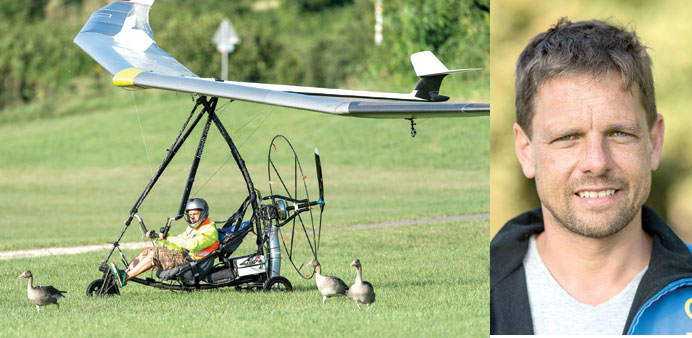THE TRAINER: Michael Quetting, 41, a staffer at Germany’s Max Planck Institute for Ornithology in Radolfzell, southern Germany, who is training the geese in flight.
By Kathrin Drinkuth
When the horn sounds, a commotion breaks out among the geese. They waddle quickly over to the ultralight aeroplane waiting for them on the runway. The motor gets going, it takes off and they take to air behind it.
Michael Quetting, a staffer at Germany’s Max Planck Institute for Ornithology in Radolfzell, southern Germany, is training the geese in flight in the hope that in return they will collect data for him.
“It’s working pretty well,” says Quetting when he lands a few minutes later. “We just have to practise formation flying.”
The biological-science technical assistant has been caring for Nemo, Nils, Gloria, Calimero and Maddin since April.
The greylag geese were selected for the quixotic experiment as eggs, and collected into two nests.
Quetting began training them even before they had hatched, using a loudspeaker to play the horn, the sounds of the propellers from the aeroplane and his voice over the nest every day for half an hour. He even read aloud to the eggs a children’s book, The Wondrous Journey of Nils Holgersson with the Wild Geese.
Since they hatched he has been their “mother goose” — at first they just waddled around after him, but now they also follow him into the air on their regular practice flights.
Quetting isn’t the first scientist to try and train birds; the Austrian behavioural scientist Konrad Lorenz (1903-1989) also worked with groups of greylag geese, training them to think he was their mother.
People have also been flying ultralights with birds for some time. In 2007, Austrian scientists guided young northern bald ibises 1,000 kilometres to their winter migration site in Tuscany in Italy.
The journey was part of a project to reintroduce the birds — which died out in Europe in the 17th century — north of the Alps.
Quetting wants to use so-called biosensors with the help of the geese. The high-resolution GPS loggers are worn on the geese’s backs and can collect 20 types of data every second.
That allows the flight behaviour of the birds to be more accurately researched, including the frequency and breadth of their wing beats.
The data can be removed and analysed after the flight and is also the reason why tame geese are needed.
“We couldn’t get to the data with wild birds,” says Quetting. “The battery on the sensor also only lasts for two hours.”
In the long-term the 41-year-old thinks that weather forecasters might be interested in the data, since it also delivers information about the air in which the geese are flying, the wind-speed and temperature, for example.
The government-funded German Weather Service (DWD) is not convinced however: at the moment it currently has no plans to work with animals wearing sensors, a spokesman responded.
Instead, they will be relying on a denser network of satellites in the future — observation from space provides pretty good meteorological information.
Nemo, Nils, Gloria, Calimero and Maddin are unconcerned about the sensors and their possible uses. They look tired after their flight and waddle uncomplainingly back into their cage.
“At the moment we’re flying three or four kilometres,” says Quetting.
Afterwards they go back to their run at the Max Planck Institute for a bit of cuddling, swimming and food with their “mother.” Quetting calls it “geese socialising.”
He’s planning on flying with the birds until October, after which the birds will be released into the wild to fend for themselves.
And will the birds recognise him if they meet again in a few years’ time?
“Yes,” according to Quetting.
“They might not come so close to me,” he says. But they’ll know who their “mother” is for the rest of their lives - in this case up to 17 years. —DPA

